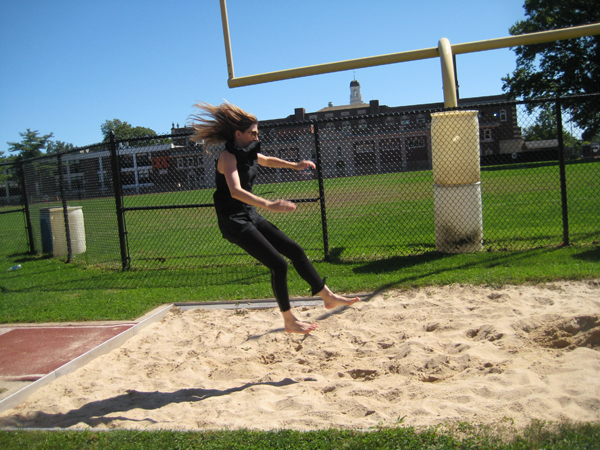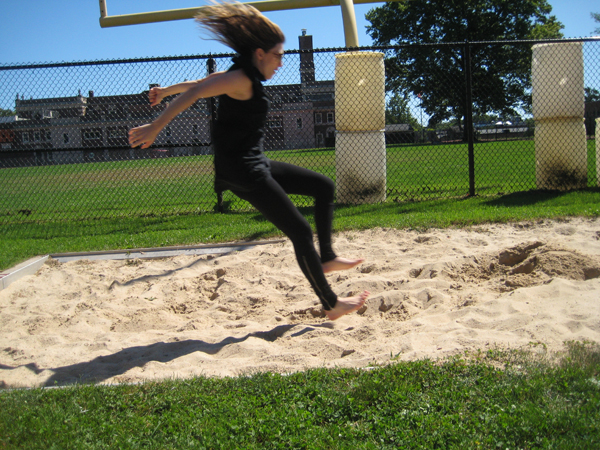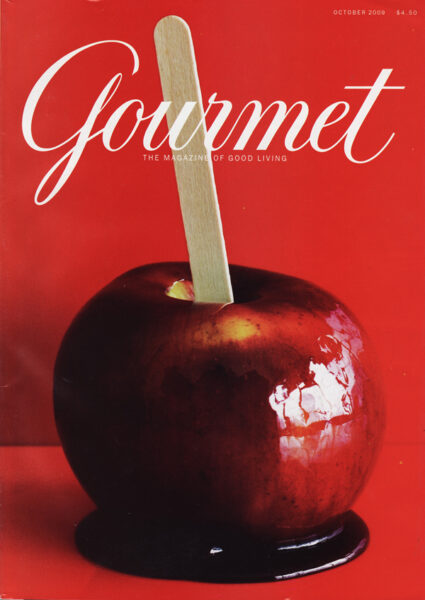Joy is free play.
I had a great weekend. My family was in town on Friday and Saturday and I had a blissfully work-free couple of days with them. On Saturday, my 10 year-old brother Rob and I took a walk and found this high school track, complete with long-jump run and sand pit. Rob has lately been getting into track and field, and knows all about Usain Bolt and other speedy individuals and the records they’re making and breaking. He’s also super-speedy himself, and a very athletic kid in general. I suggested he take a few jumps and I photograph them, trying to see if I could time the shutter just right so I could get him in midair.
But after 2 or 3 jumps I couldn’t help myself, and I had to play too. In 5 seconds my shoes were off and I sprinted barefoot down the rubber runway, launching full-tilt into the air in some sort of modified jeté. It was a feeling of complete freedom, like the way it feels to fly in a dream. The moment my feet touched the ground, I wanted to do it again. We took turns jumping and photographing each other, and honestly I could have played there all day.
As a kid, this sort of spontaneous physical play was natural, and I find myself missing it as an adult. How often I would like to kick off the high heels and play an impromptu game of tag or race a friend to the nearest streetlight, or walk a railing like a balance beam. Free physical play, play that has no purpose and no immediate end, is powerful in its ability to destress and enable creativity, and provide a conduit to the kind of joy this blog celebrates.
There’s a lot to be learned from formal definitions of play. Stuart Brown, the head of the National Institute for Play, describes play as follows. It’s apparently purposeless activity, meaning it’s one of the few things we do for its own sake, not as a means to some end. It’s voluntary, and we have an inherent attraction to it (as do many animals). It provides a freedom from time and a diminished consciousness of self, which means that play creates a perspective shift where we forget about how we look and our to-do lists and become totally present in the moment. Play also provides improvisational potential, meaning its not overly prescribed, an extremely important but often overlooked criterion. And play creates a continuation desire; in other words, we’d like play to go on as long as possible, and once it’s over, we’d like to repeat it soon after.
To the letter, this was my experience at the track this weekend. Though there are 19 years between us, Rob and I had the same inherent attraction to the play experience. We both felt lost in the moment, and had no consciousness of time passing. While in air I didn’t care whether my hair was out of place or how good a jumper I was. (In fact, Rob is a much better jumper than I am, but I’ve redacted the photos until he’s at least old enough to have a Facebook page!) The activity was incredibly simple, yet was open-ended enough to provide endless potential for improvisation: jumping in different ways, launching at different points in the track, spinning or performing other silly stunts in midair. And the continuation desire was evident in the fact that Rob and I both had to do “just one more” jump a few times before we could tear ourselves away.
“Play” has been a popular buzzword lately, and yet it often seems to be used without a real understanding of the ideas described above. Designs are described as playful if they exhibit childlike qualities, but just being brightly colored and out-of-scale doesn’t necessarily make something playful. Play is about attitude, behavior, and affordances, something that manifests in aesthetics, but stems from something inherently deeper than that.
I’ll be exploring play’s role in aesthetics of joy on the blog this week, and showing some examples of how the spirit of play manifests itself in the design of objects and experiences. Do you have stories or thoughts on play and joy in your own life? If so, write them in the comments — I’d love to hear them.







Leave a Comment